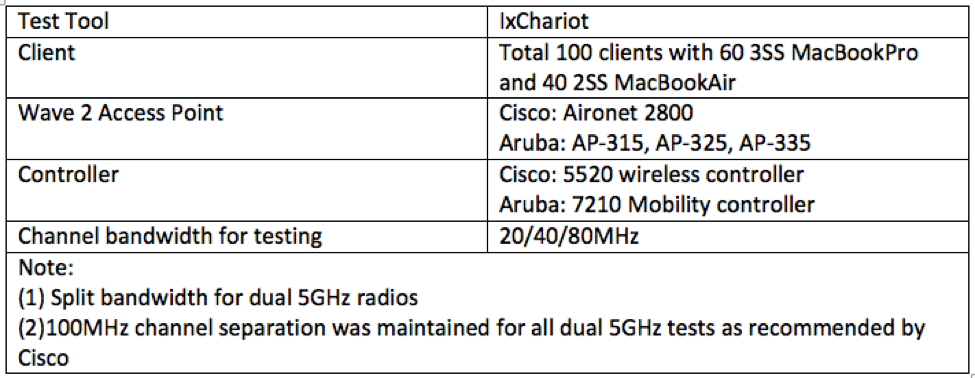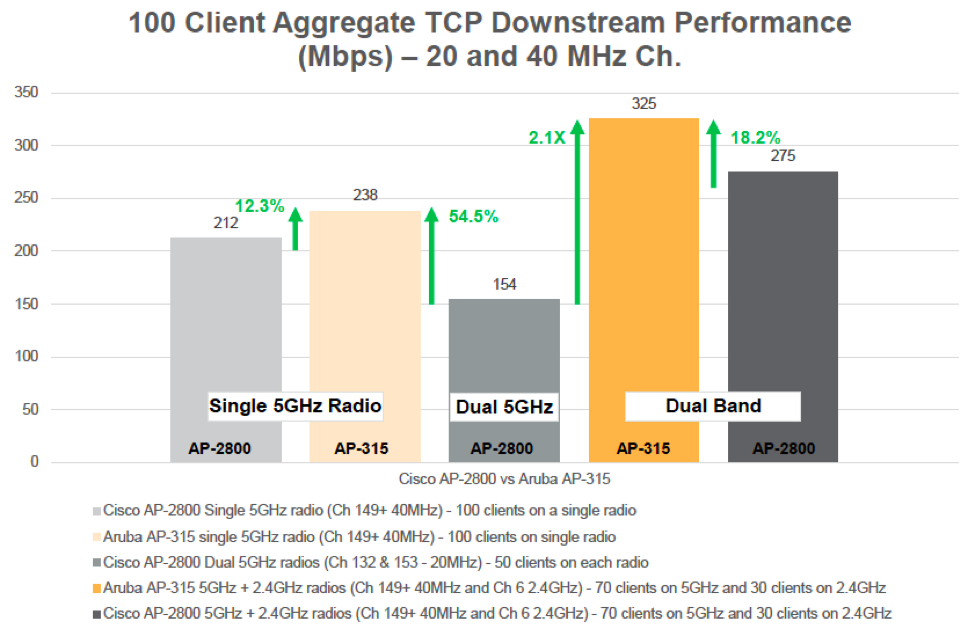A few months ago, we discussed if enterprises are ready to deploy a 5GHz only wireless network. Many concerns were brought out with regards to the “5GHz-only network” including the nature of the Wi-Fi radios (resulting in excessive interference), the client availability and the design of enterprise networks. It was concluded that deploying a 5GHz-only network won’t be able to satisfy the needs in enterprise environments.

However, some may still argue that a 5GHz-only network with dual 5GHz bands, will deliver higher performance. With this hypothesis in mind, some WLAN vendors started to design their APs with the support of dual 5GHz bands. Cisco is one of these vendors.
Touting the support of dual 5GHz radios, Cisco claimed that its AP-2800 and AP-3800 maximize “the benefits of 802.11ac Wave 2”, increase “client device capacity” and deliver an astounding max PHY data throughput of 5.2Gbps per AP. That sounds great in theory until you look into the details behind the claims:
- For each radio to reach 2.6Gbps, the AP has to use 160MHz wide channels. However, because 160MHz only has two channels, designing and deploying an enterprise network is not practical due to the adjacent and co-channel interferences. Until the FCC opens up more spectrum in 160MHz, APs will continue to run on 20/40/80MHz. With 80MHz, the max data rate will be reduced by half to 1.3Gbps/radio. And this assumes there is no interference between the two 5 GHz radios when co-located.
- The performance boost when driving up to 5.2Gbps would easily overwhelm the AP CPU and other resources if not designed well when using two 5GHz radios.
To validate if Cisco’s support of dual 5GHz radios really drives up performance for the network as they claim, we recently ran a series of performance tests with the Cisco AP-2800 which claimed the same 5.2Gbps/AP data rate as the AP-3800. To measure performance, we used three different Aruba Wave 2 APs as part of the tests. Let’s take a look at the details:
Test Environments

As shown in Figure 1 below, the tested APs were mounted on the ceiling for best coverage, and 100 Clients were positioned 15ft away from tested APs to simulate a dense deployment environment.

Figure 1: test setup in a large room
Test Results
The collected data from numerous tests delivered consistent results.
Test #1
In this test, multiple scenarios were tested in 40MHz (20MHz/radio if for dual 5GHz radios):
- The Cisco AP-2800 operated in the single 5GHz radio; dual 5GHz radios; dual-band 5GHz and 2.4GHz radios
- The Aruba AP-315 operated in the single 5GHz radio; dual-band 5GHz and 2.4GHz radios

Figure 2: Test result -1
A total of 100 clients were assigned equally to each radio based on the channel bandwidth. In other words, 50 clients for each radio in dual 5GHz, 70 clients for the 5GHz radio and 30 clients for the 2.4GHz radio in dual-band (5GHz/2.4GHz). Figure 2 shows the test results:
- The Aruba 315 on single 5GHz had 54% gain over Cisco’s AP-2800 on dual 5GHz radios
- The Aruba 315 on dual-band (5GHz/2.4GHz) outperformed Cisco’s AP-2800 on dual 5GHz radios by more than two times.
- The Cisco AP-2800 performed better when running on dual band (5GHz and 2.4 GHz) than on dual 5GHz radios
- The Cisco AP-2800 on dual 5GHz radios delivered the lowest aggregate TCP downstream data rate during the tests
Test #2
In this test, 80MHz was used for single 5GHz. When used for dual 5GHz radios, the bandwidth was split to 40/40MHz. The Cisco AP-2800 was tested for both single 5GHz and dual 5GHz radios; The Aruba AP-315/325/335 APs were tested for single 5GHz. Total 100 clients were connected to each tested AP. Figure 3 shows the test result with details on the number of clients for each radio, channels used and the channel bandwidth for each AP.

Figure 3: Test result - 2
- Like in test #1, the Cisco AP-2800 on dual 5GHz radios had the poorest performance compared to other APs tested on the single 5GHz radio. In fact, Cisco(AP-2800) ‘s single 5GHz on 80MHz even outperformed its dual 5GHz on 40MHz by about 25%, while other Aruba APs on single 5GHz led the performance by up to 87%.
- The Aruba 315 on single 5GHz (without using the 2.4GHz band) offered 68% capacity gains over Cisco’s dual 5GHz AP.
Test #3
In this test, Aruba’s dual band APs (AP-315/325/335) were tested against Cisco’s AP-2800 in dual 5GHz radios. 80MHz was used for the single 5GHz band and 40MHz was used for each radio in the dual 5GHz mode. The test results showed the amazing 2X more capacity gains in all Aruba APs when compared to the Cisco AP-2800. Figure 4 illustrates the test scenarios and the performance difference between the Cisco AP-2800 and Aruba Wave 2 APs.

Figure 4: Test result - 3
Takeaway: Cisco’s Dual 5GHz story fails to impress
Although it sounds great on the paper, the dual 5GHz story delivered false and misleading messages. It ignored the fact that in dual 5GHz mode, client data rates are unavoidably cut in half. The Cisco AP-2800’s poor performance among all tested APs in either single band or dual (5GHz/2.4GHz) bands only unveiled the hidden fact: two 5GHz radios on the same AP would adversely impact the max performance and add no additional capacity benefits. Due to currently available spectrum, Cisco shouldn’t be recommending dual 5GHz in very high-density environments due to their performance deterioration.
Unless further enhancements in RF filtering and isolation between radios are added to the dual 5GHz mode, and more spectrum is opened in 160MHz, customers should take additional care in designing an environment with dual 5GHz radios.
Why do Aruba Wave 2 APs outperform the Cisco 2800?
Aruba Wave 2 APs were purposely designed with value added technologies to deliver fast data speeds for very high device density areas and digital workplaces where the capacity needs are driven by BYOD, IOT, applications and videos, etc. Aruba Wave 2 APs offer many advantages to optimize available capacity and airtime to improve the overall network performance to meet enterprises’ data requirements:
- The patented enhanced ClientMatch technology was built in all Wave 2 APs to improve the network efficiency and user experience.
- The advanced cellular filtering capabilities in Aruba Wave 2 APs enhanced the network’s co-existence ability with cellular networks. This is particularly important in an environment where multiple access solutions are deployed.
- Aruba Wave 2 APs (AP-315 and AP-335) support the full 4SS MU-MIMO for the highest network capacity while most other vendors, including Cisco, only support up to 3SS MU-MIMO on their Wave 2 APs.
More information about Aruba Wave 2 APs, click here: AP-315, AP-325, AP-335
#AP-300